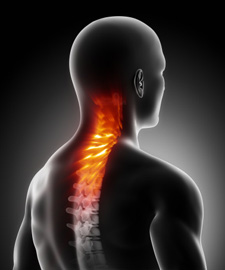
We can help to correct neck issues
According to the U.S. National Sleep Foundation, sleep apnea is as common as Type 2 Diabetes.
Risk factors include being male (men suffer from it twice as often as women), overweight, and past the age of 40. But it can affect anyone at any age, even children.
The name comes from a Greek word that literally means “without breath.” What happens is that, during sleep, you have one or more pauses in breathing, or your breath becomes extremely shallow. These pauses can last from a few seconds to minutes, perhaps as often as 30 times an hour. When you start breathing again, it can provoke a loud snort or choking sound that disrupts your sleep.
Of the three types of apnea, the most common is Obstructive Sleep Apnea (OSA), in which extra throat tissue or tonsils block the airway.
Not surprisingly, sleep apnea makes it practically impossible to get a good night’s sleep. That’s going to leave you tired, muddled, and unproductive during the day. It doesn’t do great things for your mood and winning personality either!
The kinds of neck issues we help to correct as Chiropractors are often linked to sleep apnea, according to several studies.
A pain in the neck
In fact, back in April 1998, the European Journal of Orthodontics published a study, “Natural head posture, upper airway morphology and obstructive sleep apnea severity in adults.” It found that patients with OSA “also tend to exhibit a craniocervical extension with a forward head posture.”
In other words, that forward tilt in the carriage of the head that we often see in our patients’ x-rays. This is what we seek to correct through regular Chiropractic adjustments and the at-home spinal rehabilitation exercises that we prescribe for some of our patients.
Remember, a neck that has a healthy alignment of the vertebrae has a nice backwards “C-curve”. If your head is tilting forward, it means you have lost some or this entire natural curve. This causes the soft tissues of your throat to compress and tighten up.
A separate cephalometric analysis in the same journal also identified “deviated head posture” as one of eight common characteristics of apnea sufferers. Cephalometric analysis is a kind of x-ray analysis that studies the relationships between different bone and dental structures in the head to identify and treat any facial growth abnormalities. It’s often used by dentists, orthodontists, and surgeons.
What does this mean?
If you suffer from sleep apnea, a loss of some or all of the natural curvature of your cervical spine could be contributing to the severity of your condition. This neck problem is common to many people, the consequence of long hours hunched over a keyboard or device, or the result of past injury.
With the proper Chiropractic care, we may be able to correct that problem in your neck. We have seen many anecdotal examples where apnea symptoms have eased with the restoration of the neck’s proper alignment.
What else you can do
It also bears noting that dietary changes can also play a pivotal role. There is of course the benefits of weight loss, if you are overweight, but in addition to this, stay away from foods that are likely to cause tissue inflammation in the body.
That means stay away from dairy, refined sugar, refined grains, and limit your intake of whole grains (especially those that contain gluten, like wheat). Eat instead those foods common to the diet of our hunter-gatherer ancestors—lots of vegetables, fruits, lean meats, fish, skinless chicken, omega-3 eggs, and nuts.
